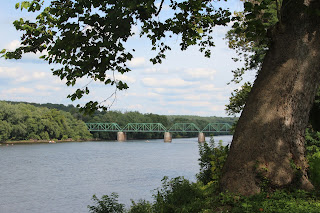 |
| Yours truly (left) with Pennsylvania Game Commission grassland bird expert Dan Mummert |
When we bought the property in 1997, the land was used to grow non-native "cool season" grasses that were harvested for hay. We started small with our conversion; each year, we would herbicide a 10- or 25-acre patch of the pasture grasses, and then reseed the area with native grass seed. In 2008 we finally finished the conversion by reseeding the final 50-acre patch.
The grasses have performed well, and our farm now looks much like a tallgrass prairie in the Midwest. Though the grassland conversion has been very successful, none of the target birds have chosen to nest in the fields yet (with the notable exception of one very rare species that occurs in only a few very scattered locations in Pennsylvania - our resounding success to date). We routinely observe Bobolinks and Eastern Meadowlarks stopping for a few days in the fields during spring and autumn migration, and each year we hope they'll linger to raise a brood, but inevitably they move on.
We have our suspicions about why they don't nest here. The largest contributor to their decision may be that the fields are just too dense with grasses, and they can't find suitable small open patches in which to build their nests. We know this is an issue, but there's a good reason why there aren't many openings in the fields: we have an absolutely horrendous problem with non-native invasive plants. Any openings in the dense grass cover are quickly colonized by invasive plants, which then begin to spread and take over the grasslands. So, we use herbicides to control the broad-leaved invasive weeds, which reduces competition for the grasses, and the grasses grow in to fill the openings. Result: no nesting sites.
 |
| Grasslands with desirably diversity |
Oh, and another thing. Our natural area is in the middle of the suburbs. We're largely surrounded by houses, roads, and businesses. So our grassland is an island in a suburban sea, and it simply may not appeal to these grassland obligates that are used to wide open expanses of grassland in an agricultural matrix.
So, long and short, we may never be successful in getting grassland obligate birds to nest in our grasslands, but it doesn't stop us from trying. One of our premier birders, Harris, called the Pennsylvania Game Commission when he learned that the commission employs a consulting grassland expert who would be willing to visit and share his knowledge and recommendations with us. The expert, Dan Mummert, visited the natural area on Tuesday, August 27 and Harris and the staff escorted Dan on a tour through the fields.
 |
| From left: Staff members Brad, Christopher, and yours truly; volunteer Harris; and Dan Mummert |
He did note that some of the grasslands contained wildflowers and that not all of the fields were grass monocultures; he encouraged us to try to create similar diversity in fields that were dominated solely by grasses. He also recommended that we remove trees that had become established in fence-rows; the trees serve as perches from which raptors can survey the fields for prey, and the trees interrupt the "flow" of the broad grassy expanses the birds are seeking. And last, but not least, he recommended that we consider closing some of our trails through the center of the grasslands during the birds' breeding season (May to mid-July) to limit disturbance by human activity.
None of these recommendations was new. We'd had other wildlife biologists make similar suggestions in the past, but it's good to hear that everyone is "singing from the same hymnal." We'll have to give all of these suggestions some thought since we have to weigh aesthetics, land management, and public use in our preserve.














































